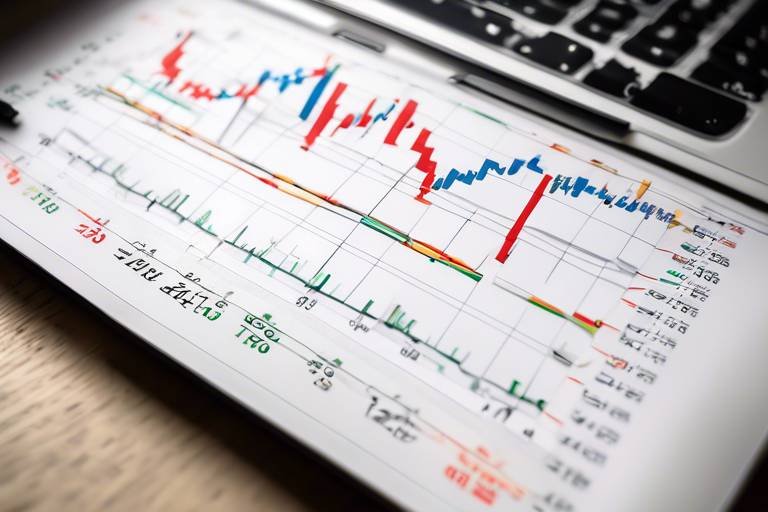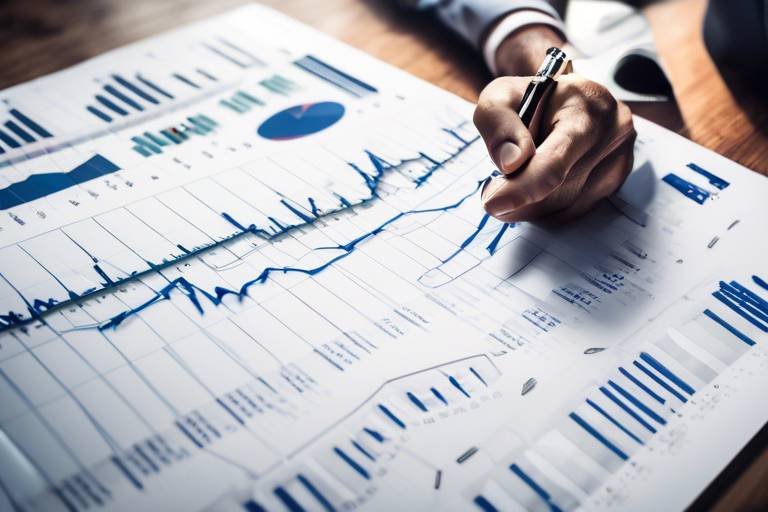How to Analyze Market Indicators for Better Trades
Trading in the financial markets can often feel like navigating a vast ocean filled with unpredictable waves and hidden currents. To successfully ride these waves, understanding market indicators is essential. Market indicators serve as navigational tools that help traders decipher complex market signals, ultimately leading to more informed and profitable trading decisions. In this article, we’ll dive deep into the world of market indicators, exploring their types, functions, and how to effectively analyze them for better trading outcomes.
Market indicators are crucial tools for traders. They provide insights into market trends, helping to predict future movements and make informed trading decisions. Think of them as the compass and map that guide traders through the often turbulent waters of the stock market. Without these indicators, traders might find themselves lost, making decisions based on gut feelings rather than solid data. By leveraging these indicators, traders can enhance their strategies and navigate the market with greater confidence.
There are various types of market indicators, including leading, lagging, and coincident indicators. Each serves a unique purpose in analyzing market trends and conditions. Understanding the differences between these indicators is vital for any trader looking to refine their approach. Let’s explore these categories further.
Leading indicators are like early warning systems; they predict future market movements, offering traders an advantage. Examples include stock market returns and consumer confidence indexes, which can signal upcoming changes. These indicators are invaluable for traders who want to get ahead of the curve. For instance, if consumer confidence is rising, it often suggests increased spending, which can bode well for certain stocks.
A common leading indicator, the Purchasing Managers' Index (PMI), provides early signs of economic expansion or contraction. When the PMI is above 50, it generally indicates that the economy is expanding, while a reading below 50 suggests contraction. By keeping an eye on the PMI, traders can anticipate market shifts and adjust their strategies accordingly.
To maximize the benefits of leading indicators, traders should combine them with other data sources. This ensures a comprehensive view of market conditions. For example, while the PMI might indicate economic growth, other indicators such as interest rates or inflation data can provide additional context. By synthesizing these various signals, traders can develop a more robust trading strategy.
In contrast, lagging indicators follow market movements and confirm trends after they occur. They are useful for validating the strength of a trend and making strategic decisions. Think of lagging indicators as the rearview mirror of trading; they help traders assess what has already happened, allowing them to make more informed choices moving forward.
Both technical and fundamental analyses play significant roles in market analysis. Understanding their differences can help traders choose the best approach for their strategies. While technical analysis focuses on price movements and chart patterns, fundamental analysis examines economic factors, company performance, and market news. Each method has its strengths and weaknesses, and savvy traders often use a combination of both to gain a more comprehensive view of the market.
Technical analysis is all about the numbers. It focuses on price movements and chart patterns, using historical data to forecast future trends. This approach is essential for short-term trading strategies, where timing is everything. By analyzing price charts, traders can identify patterns that may indicate future price movements. For instance, a trader might notice a stock consistently bouncing off a certain price level, suggesting a strong support level.
On the other hand, fundamental analysis digs deeper into the underlying factors that drive market movements. It examines economic indicators, company performance, and market news. This approach provides a broader context for trading decisions, particularly for long-term investments. For example, a trader might analyze a company's earnings reports, market share, and industry trends to determine whether a stock is undervalued or overvalued.
- What are market indicators? Market indicators are statistical measures that provide insights into market trends and help traders make informed decisions.
- How do I use leading indicators? Leading indicators can be used to predict future market movements, but they should be combined with other data sources for a comprehensive analysis.
- What is the difference between technical and fundamental analysis? Technical analysis focuses on price movements and patterns, while fundamental analysis examines economic factors and company performance.

Understanding Market Indicators
Market indicators are crucial tools for traders, acting as a compass in the vast ocean of financial data. They provide insights into market trends, helping traders predict future movements and make informed decisions. Think of market indicators as the signposts along a winding road; without them, navigating the complex landscape of trading would be like driving blindfolded. By interpreting these indicators effectively, traders can enhance their strategies and improve profitability.
To truly grasp the significance of market indicators, it's essential to understand their role in the trading ecosystem. Market indicators can be broadly categorized into three types: leading, lagging, and coincident indicators. Each type serves a unique purpose in analyzing market trends and conditions. For instance, leading indicators offer foresight into potential market movements, while lagging indicators confirm trends after they have occurred. Coincident indicators, on the other hand, provide real-time insights into current market conditions.
Consider this analogy: if the market were a theatrical performance, leading indicators would be the previews that hint at the plot twists to come, lagging indicators would be the reviews that reflect on the performance after it has ended, and coincident indicators would be the audience's reactions during the show. By understanding how these indicators function, traders can better position themselves to make strategic decisions that align with market dynamics.
Moreover, the interpretation of market indicators isn't just about numbers and charts; it's about storytelling. Each indicator tells a story about market sentiment, economic conditions, and investor behavior. For example, a sudden spike in consumer confidence can signal an impending economic upswing, while a decline in manufacturing activity might indicate looming challenges. Therefore, traders must not only analyze the data but also contextualize it within the broader economic narrative.
In conclusion, understanding market indicators is a vital skill for any trader looking to enhance their trading strategies. By leveraging the insights provided by these indicators, traders can navigate the markets with greater confidence and precision. So, the next time you're analyzing data, remember to look beyond the numbers and uncover the stories that lie within.

Types of Market Indicators
This article explores essential market indicators that can enhance trading strategies, providing insights into how to interpret data effectively for improved decision-making and profitability.
Market indicators are crucial tools for traders. They provide insights into market trends, helping to predict future movements and make informed trading decisions.
When diving into the world of trading, understanding the various types of market indicators is like having a treasure map; it guides you toward making smarter decisions. There are three primary categories of market indicators: leading indicators, lagging indicators, and coincident indicators. Each type plays a unique role in helping traders analyze market conditions and trends.
Leading indicators are like the early birds of the market; they provide hints about future movements before they happen. By analyzing these indicators, traders can gain a crucial advantage. For instance, stock market returns and consumer confidence indexes are classic examples that can signal upcoming changes in the market landscape. Imagine being able to predict a storm before it hits; that’s the power of leading indicators!
A standout example of a leading indicator is the Purchasing Managers' Index (PMI). This index provides early signs of economic expansion or contraction, allowing traders to anticipate market shifts. For instance, if the PMI shows an increase, it often suggests that businesses are purchasing more materials, which can indicate economic growth. Conversely, a decline in PMI may signal a slowdown, prompting traders to adjust their strategies accordingly.
To truly harness the power of leading indicators, traders should not rely on them in isolation. Instead, consider combining them with other data sources, like technical analysis or fundamental insights. This approach ensures a comprehensive view of market conditions, much like assembling a jigsaw puzzle where each piece adds clarity to the bigger picture. By integrating multiple indicators, traders can make more informed decisions and enhance their trading strategies.
On the flip side, we have lagging indicators, which follow market movements and confirm trends after they occur. Think of them as the rearview mirror in your car; they help validate the strength of a trend and guide strategic decisions based on what has already happened. Common examples include moving averages and the unemployment rate. These indicators can be particularly useful for traders who prefer a more cautious approach, waiting for confirmation before making their next move.
Both technical and fundamental analyses play significant roles in market analysis. Understanding their differences can help traders choose the best approach for their strategies.
Technical analysis focuses on price movements and chart patterns, using historical data to forecast future trends. It is essential for short-term trading strategies, allowing traders to capitalize on price fluctuations and market momentum.
Fundamental analysis examines economic factors, company performance, and market news. It provides a broader context for trading decisions, particularly for long-term investments, helping traders understand the underlying forces driving market changes.
- What are market indicators? Market indicators are statistical measures that provide insights into market trends and conditions, helping traders make informed decisions.
- How do leading indicators work? Leading indicators predict future market movements, allowing traders to anticipate changes before they occur.
- Can I rely solely on lagging indicators? While lagging indicators can confirm trends, they should not be used in isolation. Combining them with leading indicators can provide a more comprehensive view.
- What is the difference between technical and fundamental analysis? Technical analysis focuses on price movements and patterns, while fundamental analysis examines economic factors and company performance.

Leading Indicators
Leading indicators are like the early birds of the trading world—they give traders a sneak peek into potential market movements before they actually happen. Imagine standing at the edge of a cliff, watching the waves crash below; the clouds overhead can hint at a storm brewing. Similarly, leading indicators help traders anticipate changes in the market landscape, allowing them to make informed decisions before the rest of the crowd catches on. These indicators are essential for anyone looking to gain a competitive edge, as they can signal upcoming shifts in economic activity.
One of the most widely recognized leading indicators is the Purchasing Managers' Index (PMI). This index surveys purchasing managers across various industries to gauge their sentiment regarding business conditions. A rising PMI typically indicates that businesses are optimistic about future growth, suggesting that economic expansion may be on the horizon. Conversely, a declining PMI can signal potential contraction. By keeping an eye on the PMI, traders can position themselves advantageously before the market reacts.
Another important leading indicator is the Consumer Confidence Index (CCI). This index measures how optimistic or pessimistic consumers are regarding their financial situation and the overall economy. High consumer confidence usually translates to increased spending, which can drive economic growth. Traders who monitor the CCI can anticipate shifts in consumer behavior and adjust their trading strategies accordingly.
To truly harness the power of leading indicators, traders should consider combining them with other data sources. For instance, using leading indicators alongside technical analysis can provide a more comprehensive view of market conditions. By analyzing price movements and chart patterns in conjunction with leading indicators, traders can confirm their predictions and make more confident trading decisions.
In summary, leading indicators are invaluable tools for traders looking to stay ahead of the curve. By understanding and interpreting these indicators effectively, traders can enhance their strategies, improve decision-making, and ultimately increase their profitability. So, the next time you're analyzing market trends, remember to keep an eye out for those early signals—they could make all the difference in your trading success.
- What are leading indicators? Leading indicators are economic factors that can predict future market movements, helping traders make informed decisions.
- How do I use leading indicators in trading? Combine leading indicators with other data sources, such as technical analysis, to gain a comprehensive view of market conditions.
- Can leading indicators guarantee successful trades? While leading indicators can provide valuable insights, they do not guarantee success. They should be used as part of a broader trading strategy.

Example of Leading Indicators
Leading indicators are like the crystal balls of the trading world, offering glimpses into what the future might hold. One of the most commonly referenced leading indicators is the Purchasing Managers' Index (PMI). This index is a survey of purchasing managers in various industries, and it reflects their sentiments about the economy's health. When the PMI is above 50, it typically signals economic expansion, while a reading below 50 indicates contraction. Traders closely monitor these shifts because they can provide early warning signs of changes in market conditions.
Another significant leading indicator is the Consumer Confidence Index (CCI). This index gauges how optimistic or pessimistic consumers are regarding their expected financial situation. A rising CCI suggests that consumers are feeling good about their finances, which often leads to increased spending and, subsequently, economic growth. Conversely, a declining CCI can foreshadow reduced consumer spending, potentially leading to a slowdown in economic activity.
Additionally, stock market returns can serve as a leading indicator as well. When stock prices are rising, it often reflects investor optimism about future economic conditions. However, it’s crucial to interpret these signals with caution. For instance, if stock prices are surging but other economic indicators are lagging, it may suggest a bubble rather than a genuine improvement in economic health.
To illustrate how these leading indicators can be interconnected, consider the following table:
| Leading Indicator | Significance | Implication for Traders |
|---|---|---|
| Purchasing Managers' Index (PMI) | Indicates economic expansion or contraction | Helps traders anticipate market shifts |
| Consumer Confidence Index (CCI) | Measures consumer optimism | Signals potential increases or decreases in spending |
| Stock Market Returns | Reflects investor sentiment | Can indicate future economic conditions |
In summary, understanding these leading indicators can significantly enhance a trader's strategy. By keeping an eye on the PMI, CCI, and stock market returns, traders can make more informed decisions that align with potential market movements. The key is to combine these indicators with other data sources to build a comprehensive view of market conditions. After all, in the world of trading, knowledge is power, and being ahead of the curve can lead to greater profitability.
- What are leading indicators? Leading indicators are metrics that predict future economic activity and market trends, providing traders with insights into potential market movements.
- Why are leading indicators important for traders? They help traders anticipate changes in the market, allowing for more informed trading decisions that can lead to increased profitability.
- Can leading indicators guarantee successful trades? No, while they provide valuable insights, they should be used in conjunction with other data and analysis methods for the best results.
- What is the difference between leading and lagging indicators? Leading indicators predict future trends, while lagging indicators confirm trends after they have occurred.

Using Leading Indicators Effectively
When it comes to trading, can be your secret weapon. Imagine you're a detective, piecing together clues to solve a mystery. Leading indicators provide those essential clues about where the market might be headed. But how do you maximize their potential? First and foremost, it’s crucial to remember that no single indicator is infallible. Instead, think of leading indicators as part of a larger puzzle. By combining them with other data sources, you can create a more comprehensive picture of market conditions.
For instance, if you're analyzing the Purchasing Managers' Index (PMI), don't just stop there. Consider incorporating other indicators such as consumer sentiment or unemployment rates. This way, you can validate the signals you’re receiving. It’s like checking the weather forecast before heading out; if it says rain, but the sun is shining bright, you might want to hold off on that umbrella just yet.
Another effective strategy is to establish a consistent review process. Set aside time each week or month to analyze your leading indicators alongside market news. This habit can help you spot trends before they become obvious to the broader market. Think of it as tuning your instrument before a concert; you want to ensure everything is in harmony before you hit the stage.
Moreover, don't forget the importance of backtesting. Use historical data to see how your chosen leading indicators performed in past market conditions. This step is akin to studying the playbook before the big game. By understanding how these indicators reacted during similar situations, you can refine your trading strategy and improve your decision-making.
Lastly, be aware of the psychological aspect of trading. Leading indicators can sometimes create a sense of urgency or fear. It’s essential to remain calm and not let emotions dictate your trades. Stick to your strategy and trust the data you’ve gathered. After all, trading is a marathon, not a sprint.
- What are leading indicators? Leading indicators are metrics that can predict future market movements, helping traders make informed decisions.
- How can I combine leading indicators with other data? You can pair leading indicators with lagging indicators or fundamental analysis to gain a more comprehensive view of the market.
- Is it necessary to backtest leading indicators? Yes, backtesting helps you understand how effective an indicator has been in past market conditions, allowing you to refine your strategy.
- Can leading indicators guarantee successful trades? No, while they provide valuable insights, they should be used as part of a broader trading strategy and not relied upon solely.

Lagging Indicators
Lagging indicators are like the rearview mirror in your car; they help you see where you've been but don't necessarily give you a clear view of where you're headed. These indicators are designed to follow market movements, confirming trends after they have already occurred. For traders, this means they can validate the strength of a trend and make more informed decisions based on solid evidence rather than speculation. Think of lagging indicators as the reliable friend who tells you what just happened, allowing you to strategize your next move.
One of the primary benefits of using lagging indicators is their ability to help traders avoid false signals. When a market is volatile, it can be challenging to determine whether a trend is genuine or just a temporary fluctuation. Lagging indicators, such as moving averages and the Relative Strength Index (RSI), provide confirmation that a trend is indeed in play, allowing traders to enter or exit positions with greater confidence.
To illustrate the effectiveness of lagging indicators, consider a simple table that compares some common types:
| Indicator | Type | Purpose |
|---|---|---|
| Moving Averages | Lagging | To smooth out price data and identify trends over a specific period. |
| MACD (Moving Average Convergence Divergence) | Lagging | To identify changes in momentum and trend direction. |
| Relative Strength Index (RSI) | Lagging | To measure the speed and change of price movements, indicating overbought or oversold conditions. |
While lagging indicators are valuable, they are not without their limitations. Since they react to price movements, they may lag behind the market, which could lead to missed opportunities or delayed reactions to market changes. Therefore, it's essential to use them in conjunction with leading indicators or other analytical tools to create a balanced trading strategy. By combining these approaches, traders can gain a more comprehensive view of market dynamics, allowing for better decision-making.
In summary, lagging indicators serve as a crucial component of a trader's toolkit. They provide confirmation of trends and help validate trading strategies, but they should be used thoughtfully and in conjunction with other market analysis methods to maximize their effectiveness. After all, in the fast-paced world of trading, having a clear view of both past and present can significantly enhance your chances of success.
- What are lagging indicators? Lagging indicators are tools that follow market movements to confirm trends after they occur, helping traders validate their strategies.
- How do I use lagging indicators effectively? Combine them with leading indicators or other analysis methods to create a well-rounded trading strategy.
- Can lagging indicators lead to missed opportunities? Yes, since they react to past price movements, they may lag behind the market, potentially causing delays in decision-making.

Technical Analysis vs. Fundamental Analysis
When it comes to trading, understanding the distinction between technical analysis and fundamental analysis is crucial for any trader looking to enhance their strategies. Think of it as choosing between two different lenses to view the market landscape. Technical analysis is like peering through a telescope, focusing on price movements and chart patterns to predict future trends. It relies heavily on historical data and statistical measures, allowing traders to identify trends and make decisions based on past performance. This method is particularly beneficial for short-term trading strategies, where timing is everything. Traders often use various tools such as moving averages, relative strength index (RSI), and candlestick patterns to make sense of price fluctuations.
On the other hand, fundamental analysis is akin to reading the entire map of the market. It examines the underlying economic factors that drive market movements, including company performance, economic indicators, and market news. This approach provides a broader context for trading decisions, especially for those who are in it for the long haul. By scrutinizing financial statements, earnings reports, and macroeconomic trends, traders can gauge a company's true value and make informed decisions about potential investments. For example, if a company reports strong earnings amidst a growing economy, fundamental analysts might see this as a green light to buy.
To illustrate the differences further, consider the following table:
| Aspect | Technical Analysis | Fundamental Analysis |
|---|---|---|
| Focus | Price movements and patterns | Economic indicators and company performance |
| Timeframe | Short-term trading | Long-term investment |
| Tools | Charts, indicators, historical data | Financial statements, news, economic reports |
| Objective | Identify entry and exit points | Assess intrinsic value and growth potential |
While both methods have their merits, many traders find that combining both analyses can yield the best results. By using technical analysis to time their trades and fundamental analysis to inform their investment choices, traders can create a more robust strategy. It's like having a GPS and a compass; each tool provides valuable information, but together, they can lead you to your destination more effectively.
In conclusion, whether you lean towards technical or fundamental analysis, understanding both approaches will empower you to navigate the complex world of trading with greater confidence. So, which lens will you choose to look through? The decision ultimately depends on your trading style and goals.
- What is the main difference between technical and fundamental analysis? Technical analysis focuses on price movements, while fundamental analysis looks at economic factors and company performance.
- Can I use both analyses together? Absolutely! Many traders find that combining both methods provides a more comprehensive view of the market.
- Which analysis is better for beginners? It depends on your trading goals. Technical analysis may be easier for short-term trades, while fundamental analysis is better for long-term investments.

Technical Analysis Overview
Technical analysis is like the art of reading the market's pulse. It focuses primarily on price movements and chart patterns, utilizing historical data to forecast future trends. Imagine trying to predict the weather; you wouldn't just look out the window, right? You’d check past weather patterns, temperature fluctuations, and even atmospheric pressure. Similarly, traders use technical analysis to interpret price charts, which can reveal a lot about potential future movements in the market.
The core principle behind technical analysis is that market prices reflect all available information. This means that everything from economic news to investor sentiment is already priced into the assets. By analyzing price movements, traders can identify trends and potential reversal points, enabling them to make informed decisions. Think of it as a treasure map; the patterns and signals on the chart guide traders to potential profits.
One of the key tools in technical analysis is the use of indicators. These mathematical calculations based on price and volume data help traders assess market conditions. Some popular indicators include:
- Moving Averages: These smooth out price data to identify trends over a specific period.
- Relative Strength Index (RSI): This measures the speed and change of price movements, indicating overbought or oversold conditions.
- Bollinger Bands: These provide a range within which a stock's price typically moves, helping traders identify volatility.
By employing these indicators, traders can achieve a more nuanced understanding of market dynamics. However, it's crucial to remember that technical analysis is not foolproof. It’s essential to combine these insights with other analyses and market news to develop a comprehensive trading strategy. In essence, technical analysis serves as a compass, guiding traders through the often turbulent waters of market fluctuations.
Moreover, traders often look for specific chart patterns that can signal future price movements. Some common patterns include:
| Chart Pattern | Description |
|---|---|
| Head and Shoulders | A reversal pattern that indicates a change in trend direction. |
| Double Top/Bottom | Patterns that signal potential reversals after a strong trend. |
| Triangles | Continuation patterns that suggest a pause before the trend resumes. |
Understanding these patterns can significantly enhance a trader's ability to predict market movements. As with any skill, mastering technical analysis takes practice and dedication. It’s like learning to ride a bike; at first, it might seem daunting, but with time and experience, it becomes second nature.
In conclusion, technical analysis is an invaluable tool in a trader's toolkit. By focusing on price movements and utilizing various indicators and chart patterns, traders can make more informed decisions. However, it’s essential to remain adaptable and combine this analysis with fundamental insights to navigate the ever-changing landscape of the market effectively.
Q: What is the main goal of technical analysis?
A: The main goal is to forecast future price movements based on historical data, helping traders make informed decisions.
Q: Can technical analysis be used for long-term investments?
A: While primarily used for short-term trading, some aspects of technical analysis can be applied to long-term investments, especially when combined with fundamental analysis.
Q: How do I get started with technical analysis?
A: Begin by studying basic chart patterns and indicators, practice analyzing historical data, and gradually develop your own trading strategy.

Fundamental Analysis Overview
When it comes to trading, understanding the broader picture is just as important as analyzing price charts. This is where fundamental analysis steps in, acting like a magnifying glass that reveals the underlying factors influencing market movements. Unlike technical analysis, which focuses on price trends and patterns, fundamental analysis digs deeper into the economic, financial, and other qualitative and quantitative factors that can impact the value of an asset. Think of it as the detective work behind the scenes, uncovering the truths that numbers alone might hide.
Fundamental analysis revolves around several key components that traders need to consider. For instance, economic indicators such as GDP growth rates, unemployment rates, and inflation provide a snapshot of a country's economic health. These indicators can significantly affect market sentiment and, consequently, asset prices. When a country's economy is booming, traders might expect stock prices to rise, while a struggling economy could lead to declines.
Moreover, company performance metrics are essential in assessing the value of individual stocks. Factors like earnings reports, revenue growth, and profit margins give traders insights into a company's operational efficiency and market position. When a company reports higher-than-expected earnings, it often results in a surge in its stock price, while disappointing results can lead to a sell-off. Therefore, keeping a close eye on these reports can provide traders with a competitive edge.
Additionally, market news and geopolitical events can have a profound impact on trading decisions. For example, announcements regarding interest rate changes by central banks can sway market sentiment dramatically. A sudden political event, such as an election or a trade agreement, can also cause volatility in the markets. Thus, staying updated with the latest news and understanding its potential implications is crucial for traders who wish to navigate the complex market landscape effectively.
To summarize, fundamental analysis is not just a tool; it’s a crucial strategy that allows traders to make informed decisions based on a comprehensive understanding of market dynamics. By analyzing economic indicators, company performance, and market news, traders can position themselves to capitalize on potential opportunities and mitigate risks. It’s like having a roadmap that guides you through the often unpredictable terrain of trading.
- What is the main difference between technical and fundamental analysis?
Technical analysis focuses on price movements and patterns, while fundamental analysis looks at economic and financial factors that influence asset values. - Why is fundamental analysis important for traders?
It helps traders understand the underlying factors driving market movements, enabling better decision-making and strategy formulation. - How can I stay updated on economic indicators?
Traders can follow financial news websites, subscribe to economic calendars, and utilize financial market apps that provide real-time updates.
Frequently Asked Questions
- What are market indicators?
Market indicators are tools that traders use to analyze and interpret market trends. They help predict future price movements, allowing traders to make informed decisions about buying and selling assets.
- What is the difference between leading and lagging indicators?
Leading indicators predict future market movements, giving traders a heads-up about potential changes. In contrast, lagging indicators follow market trends and confirm movements after they occur, helping to validate the strength of those trends.
- Can you give examples of leading indicators?
Sure! Common examples of leading indicators include the Purchasing Managers' Index (PMI) and consumer confidence indexes. These indicators signal potential economic changes before they happen, which can be crucial for traders looking to stay ahead of the curve.
- How can I effectively use leading indicators?
To maximize the benefits of leading indicators, it's essential to combine them with other data sources. This way, you can gain a comprehensive view of market conditions and make more informed trading decisions.
- What role does technical analysis play in trading?
Technical analysis focuses on price movements and historical data to forecast future trends. It's vital for short-term trading strategies, helping traders understand market patterns and make timely decisions based on price action.
- What about fundamental analysis?
Fundamental analysis looks at economic factors, company performance, and market news. It provides a broader context for trading decisions, particularly useful for long-term investments where understanding the underlying value of an asset is crucial.
- How do I choose between technical and fundamental analysis?
Choosing between technical and fundamental analysis depends on your trading style. If you prefer short-term trades based on price movements, technical analysis might be your best bet. However, if you're looking at long-term investments, fundamental analysis could provide the insights you need.



















